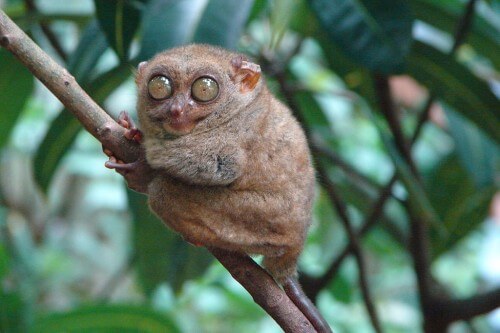Think you can see well at night? Think again. The Indonesian terasius, or the Indonesian kippo, is indeed one of the smallest species of monkey, but it has the largest eyes in relation to its head among mammals - all to eat insects...

By: Dafna Haim Langford
Think you can see well at night? Think again. The Indonesian terasius, or the Indonesian kippo, is indeed one of the smallest species of monkey, but it has the largest eyes in relation to its head among mammals - all to eat insects...
The Terasius lives in the rainforests of the Indonesian islands. The eyes, which give the Indonesian teresius that sweet, dumbfounded look, are his main sensory organ, and they allow the teresius to hunt its prey even in the darkest of nights.
Tarsius' eyes are so large in relation to his head, that the volume of each eye is greater than the volume of the entire brain! The Tarsius is a nocturnal animal that feeds on hunting insects, and therefore needs very sharp vision, which will enable the detection of small insects in little light.
In Tarsius, therefore, sharp vision developed in a wide field of vision by preserving the greatest density of canes (highly sensitive light receptors) in a large area in the center of vision. In addition, the area of the center of vision, the Fovea, is significantly larger than in other mammals. A large lens and a large horn enable increased light absorption and together complement the ability to absorb information from the environment. But of course it is not enough to absorb a lot of information, it is also necessary to process it. Indeed, it was found that the visual cortex is unique to Tarsius in that the area of the visual center in the brain of Tarsius is the largest in relation to the neocortex in all mammals. To compensate for the limitation of the movement of the eyes as a result of their size, the Tarsius is able to move the head about 180 degrees.
Terasius' eyes are not the only organ that broke the record for size in relation to the body. The anatomy of his legs is also unique. His legs are extremely long, and allow him to advance in leaps and bounds for a distance 40 times his length, this through a structure that allows for shock absorption. Terasius' hands are also particularly long in relation to the body among mammals, a fact that allows him to grab and collect - despite the lack of a thumb. To compensate for the lack of a thumb, Tarsius' third toe turns out to be almost as long as his arm. Was Tarsius a source of inspiration for IT?
It seems that evolution has definitely been working overtime on this tiny creature, which fossils suggest has been here in this configuration for over 40 million years.

4 תגובות
It is admittedly a very old word, but it is better than "evolution worked on it overtime" just so that it could eat at night, it would have been much easier to develop a different diet such as vegetarianism and eat day and night without all the equipment for night vision and shock absorbers, etc. that evolution developed 40 million years ago No ?
D.
Beautiful. I liked.
"Tersius' eyes are so large in relation to his head, that the volume of each eye is greater than the volume of the entire brain! "
And not only Tarsius: everyone who has big eyes - has a small brain.
40 million years without change? A sign that he is more perfect than Lucy!